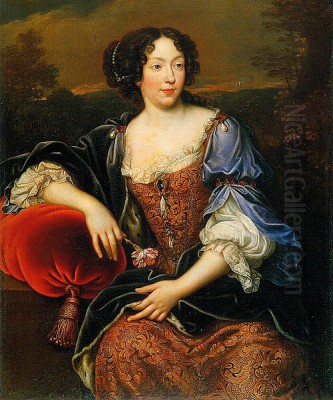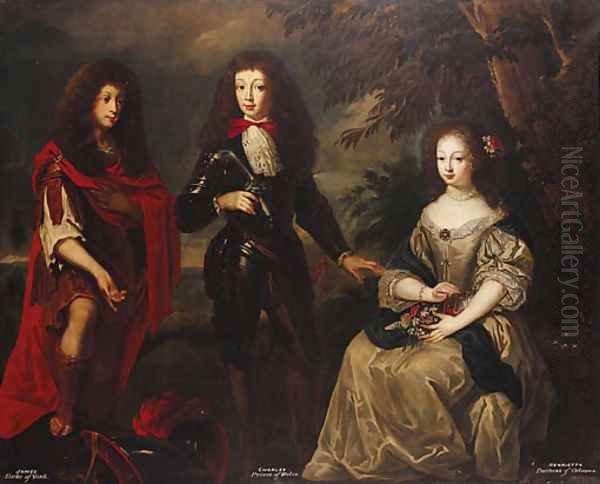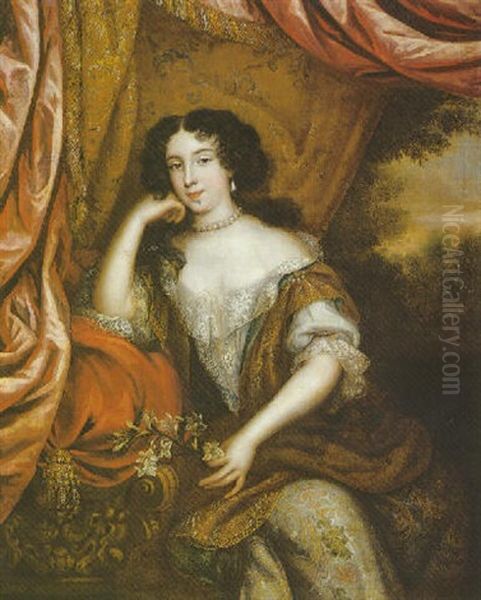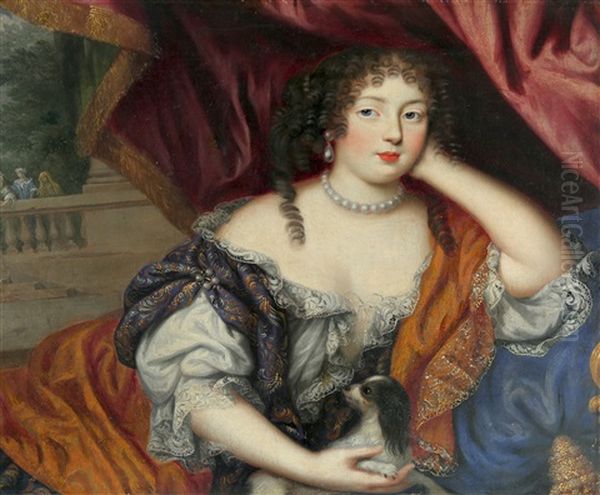Introduction: An Artist Between Courts

Henri Gascar (1635–1701) stands as a fascinating figure in the landscape of late seventeenth-century European art. A French painter by birth and training, Gascar achieved significant recognition not only in his native Paris but also, perhaps more notably, during a highly productive period spent in Restoration England. His career trajectory, moving between the artistic hubs of Paris, London, and finally Rome, reflects the cosmopolitan nature of the Baroque era, where artists often sought patronage and inspiration across national borders. Specializing in portraiture, Gascar brought a distinctly French sensibility – characterized by elegance, elaborate compositions, and a certain theatrical flair – to the courts and aristocratic circles he served, leaving behind a body of work that captures the personalities and opulent aesthetics of his time. While perhaps less universally known today than some of his direct contemporaries like Sir Peter Lely or Godfrey Kneller, Gascar's contribution to portraiture, particularly his work for the court of Charles II, remains significant for its style and historical insight.
Parisian Origins and Early Career
Born in Paris in 1635, Henri Gascar emerged during a period when the French capital was solidifying its position as a dominant cultural center in Europe, under the burgeoning reign of Louis XIV. Information about his specific training is scarce, a common issue for many artists of the period not directly associated with major workshops from the outset. However, it is reasonable to assume he received a solid grounding in the fundamentals of drawing and painting prevalent in Paris at the time. The artistic environment was heavily influenced by the Académie Royale de Peinture et de Sculpture (Royal Academy of Painting and Sculpture), founded in 1648, which promoted a classicizing, formal style often associated with Charles Le Brun, the leading court painter.

Gascar's early work likely developed within this context, absorbing the French taste for formal portraiture that emphasized dignity, rich materials, and often allegorical or symbolic elements. Painters like Pierre Mignard, a rival to Le Brun known for his elegant portraits, also shaped the artistic milieu. Gascar's own father, Pierre Gascar, was reportedly a minor painter and sculptor, suggesting an early exposure to the artistic world. Henri's developing style would eventually blend this French foundation with influences encountered later in his career, but the elegance and compositional sophistication characteristic of French Baroque art remained a hallmark of his work throughout his life. His decision to eventually seek fortune abroad, particularly in England, was not unusual for ambitious artists seeking new markets and patronage opportunities.
Arrival and Success in Restoration England
Henri Gascar arrived in England around 1674. This was the height of the Restoration period, following the return of the monarchy in 1660 with King Charles II. The English court, after the austerity of the Commonwealth, embraced continental sophistication, particularly French styles in fashion, manners, and art. Charles II's court was known for its glamour, intrigue, and a certain degree of libertinism, providing fertile ground for portraitists who could capture the era's opulence and the personalities of its key players. The dominant portrait painter at the time of Gascar's arrival was Sir Peter Lely, a Dutch-born artist who had masterfully chronicled the court beauties and leading figures.
Gascar, however, offered something slightly different. His style was perceived as more overtly French, perhaps more flamboyant and decorative than Lely's, which, while elegant, retained a certain Dutch solidity. This French manner proved highly appealing, particularly to certain factions within the court. Gascar quickly found favour, most significantly with Louise de Kéroualle, Duchess of Portsmouth. A French noblewoman who became one of Charles II's most influential mistresses, the Duchess of Portsmouth was a key conduit of French taste and political influence at the English court. Her patronage was instrumental in launching Gascar's English career.
Through the Duchess's support, Gascar gained access to the highest echelons of English society. He was commissioned to paint numerous portraits of courtiers, aristocrats, and especially the ladies associated with the King. His success was rapid, and contemporary accounts suggest he amassed considerable wealth during his time in England. His ability to flatter his sitters while employing a rich, decorative style perfectly suited the demands of a court eager to project an image of splendour and sophistication.
Artistic Style: French Flair and Baroque Sensibilities

Henri Gascar's artistic style is best understood as a sophisticated variant of French Baroque portraiture, adapted for an English clientele but retaining its continental origins. His work is characterized by a refined elegance, a rich colour palette, and a penchant for elaborate compositions featuring luxurious fabrics, detailed settings, and often symbolic accessories. Compared to the somewhat more standardized poses often found in the later work of Sir Peter Lely or the emerging Godfrey Kneller, Gascar's portraits frequently display a greater sense of movement and theatricality.
His figures are often presented in dynamic or slightly unconventional poses, draped in silks, satins, and velvets rendered with meticulous attention to texture and sheen. He excelled at capturing the intricate details of lace, jewellery, and elaborate hairstyles fashionable at the time. Backgrounds are rarely plain; Gascar often incorporated landscape elements, architectural features, or sumptuous drapery to create a sense of depth and context, enhancing the sitter's status. This decorative richness aligns well with the broader aesthetics of the Baroque period, which favoured drama, opulence, and visual complexity.
Gascar also employed symbolism and allegory, common devices in Baroque portraiture used to convey messages about the sitter's identity, virtues, or social standing. For example, the inclusion of specific flowers, animals (like the lapdogs favoured by court ladies), or mythological references could add layers of meaning accessible to contemporary viewers. His handling of paint is generally smooth and polished, aiming for a high degree of finish that emphasizes the refinement of his subjects. While perhaps lacking the deep psychological insight found in the greatest masters like Rembrandt, Gascar's skill lay in creating visually stunning images that perfectly captured the outward glamour and aspirations of his aristocratic patrons. His style offered a distinct alternative to the established Anglo-Dutch manner, contributing to the diversity of portraiture available in Restoration England.
Key Patrons and Notable Sitters
Henri Gascar's success in England was significantly tied to his ability to attract high-profile patrons. His most important connection was undoubtedly Louise de Kéroualle, the Duchess of Portsmouth. As a prominent figure at court and a fellow French national, she provided Gascar with crucial introductions and commissions. Her patronage not only secured his financial success but also placed him at the center of court life. Gascar painted the Duchess multiple times, often in allegorical or highly flattering guises that emphasized her beauty and influence. These portraits served not only as personal records but also as tools in the complex game of court politics, projecting an image of power and favour.

Another significant sitter from Charles II's circle was Barbara Villiers, Duchess of Cleveland, another of the King's powerful mistresses. Like the Duchess of Portsmouth, she was a celebrated beauty and a key figure at court, and her portrait by Gascar would have been a prestigious commission. Gascar also painted several of the Queen's Maids of Honour, capturing the youthful elegance of the ladies who attended Queen Catherine of Braganza. These portraits contributed to the visual record of the court's female luminaries, a genre popularized by Sir Peter Lely's famous "Windsor Beauties" series.
Perhaps one of his most important male sitters was James, Duke of York, the King's brother and heir presumptive (later King James II). Gascar's portrait of the Duke, depicted with attributes related to his position and interests (such as maritime symbols referencing his role as Lord High Admiral), is a significant example of formal male portraiture in the French style. Painting the future king was a clear indicator of Gascar's standing. While his association with the King's mistresses brought him fame and fortune, it also attracted criticism from satirists who targeted the perceived extravagance and foreign influence at court, implicitly linking Gascar to these critiques. Nonetheless, his roster of sitters reads like a 'who's who' of the Restoration elite.
Masterworks: Capturing the Restoration Elite
Several key works exemplify Henri Gascar's style and his contribution to Restoration portraiture. His portrait of James, Duke of York (c. 1675) is a prime example of his formal manner. The Duke is presented in a confident pose, clad in armour but softened by luxurious fabrics, set against a backdrop that includes maritime elements. The composition is grand and imposing, utilizing rich colours and textures to convey the sitter's high status and authority. The French influence is palpable in the elegance of the pose and the overall decorative effect, distinguishing it from the slightly more sober approach often seen in contemporary English male portraits by artists like John Riley.
Gascar's portraits of Louise de Kéroualle, Duchess of Portsmouth, are perhaps his most famous works from the English period. Often depicted in allegorical or pastoral settings, these paintings emphasize her beauty, sophistication, and connection to the King. One notable portrait shows her reclining languidly, accompanied by a King Charles Spaniel (a subtle nod to her royal lover), surrounded by opulent silks and drapery. The composition is sensual and highly decorative, showcasing Gascar's skill in rendering textures and creating an atmosphere of luxurious intimacy. These portraits were instrumental in crafting the Duchess's public image.

Similarly, his portraits of other court ladies, such as Barbara Villiers, Duchess of Cleveland, or the Maids of Honour, follow this pattern of elegant presentation, rich attire, and flattering portrayals. He often employed slightly soft-focus effects and idealized features, conforming to the conventions of courtly beauty. While individual characterization might sometimes be secondary to achieving an overall effect of grace and status, these works provide invaluable visual documentation of the key personalities and the aesthetic preferences of Charles II's court. They demonstrate Gascar's ability to deliver the kind of sophisticated, continental glamour that his patrons desired.
Return to France and the Académie Royale
Despite his considerable success and financial rewards in England, Henri Gascar did not settle there permanently. Around 1680, after approximately six years in London, he returned to his native Paris. His reasons for leaving England are not explicitly documented but could have involved shifting political tides, a desire to return home, or perhaps the saturation of the London market with portraitists, including the increasingly dominant Godfrey Kneller, who arrived in England in 1676.
Upon his return to Paris, Gascar sought official recognition within the French artistic establishment. In 1680, he achieved a significant milestone by being received into the prestigious Académie Royale de Peinture et de Sculpture. Membership in the Académie was the highest honour for an artist in France, signifying royal approval and placing him among the elite of his profession. His reception piece, the work submitted to demonstrate his skill, was likely a portrait, although specifics are sometimes debated. This acceptance confirmed his status and reintegrated him into the mainstream of French art, under the watchful eye of figures like Charles Le Brun.
His return to Paris placed him back in the orbit of French contemporaries such as Hyacinthe Rigaud and Nicolas de Largillière, who were becoming the leading portraitists of the next generation, known for their grand depictions of Louis XIV's court and the rising bourgeoisie. Gascar's time in England, however, had given him a unique international experience and a portfolio of high-profile commissions that likely enhanced his reputation upon his return. His membership in the Académie solidified his standing before his final move abroad.
Later Years in Rome and Death
Henri Gascar's stay in Paris after his return from England was relatively brief. In 1681, just a year after being accepted into the Académie Royale, he left France once again, this time heading south to Italy. He chose to settle in Rome, the eternal city that had drawn artists for centuries with its unparalleled legacy of classical antiquity and Renaissance and Baroque masterpieces. Rome remained a major artistic center, attracting painters, sculptors, and architects from across Europe who came to study, work, and seek patronage from the Church and the Roman aristocracy.
In Rome, Gascar continued his career as a portrait painter, presumably adapting his style to suit local tastes while retaining his characteristic French elegance. The artistic environment in Rome at this time was vibrant, with Italian masters like Carlo Maratta dominating the scene, known for his classical compositions and refined style, which resonated with the academic traditions Gascar knew from Paris. Gascar would have encountered a diverse community of international artists during his time there.
He remained in Rome for the last two decades of his life, continuing to paint until his death in 1701. While his Roman period is perhaps less documented and studied than his time in England, his decision to settle there suggests a continued ambition and a desire to engage with the heartland of classical and Baroque art. His death in Rome marked the end of a long and geographically diverse career that spanned the major artistic centers of late seventeenth-century Europe. His journey from Paris to London and finally to Rome highlights the mobility and adaptability required of successful artists in this era.
Contemporaries and the Artistic Milieu
Henri Gascar operated within a rich and competitive artistic landscape populated by numerous talented painters across Europe. In France, during his formative years and later return, the dominant figures were Charles Le Brun, the powerful director of the Académie and chief painter to Louis XIV, and his rival Pierre Mignard, both masters of the grand style. Younger portraitists like Hyacinthe Rigaud and Nicolas de Largillière were rising to prominence, developing the elaborate state portraiture that would define the later years of Louis XIV's reign. Gascar's work shares the elegance of Mignard and the decorative richness found in the broader French school.
In England, his primary competitor was initially Sir Peter Lely, whose established workshop dominated court portraiture until his death in 1680. Lely's style, influenced by Van Dyck and Dutch painting, was elegant but perhaps less overtly flamboyant than Gascar's. After Lely's death, Godfrey Kneller, a German-born painter who arrived in 1676, rapidly rose to become the leading portraitist, establishing a highly efficient studio and a style that would dominate English painting for decades. Other notable painters active in England during Gascar's time included John Riley, known for his more direct and less idealized portraits, and Willem Wissing, another Dutch artist who enjoyed court favour. The female painter Mary Beale also ran a successful professional practice, and as noted in the source material, attribution issues sometimes arise between these artists, highlighting the stylistic overlaps and workshop practices of the period.
Gascar's international career also placed him in the context of Dutch masters, whose influence was felt throughout Europe (though direct interaction is not documented), and later, Italian painters like Carlo Maratta in Rome. The towering influence of earlier masters like Anthony van Dyck, whose elegant portrait style had profoundly shaped English portraiture, provided a backdrop against which all these later artists worked. Gascar navigated this complex milieu, carving out a niche with his distinctively French interpretation of Baroque portraiture.
Anecdotes, Controversies, and Legacy
Henri Gascar's career was not without its share of interesting anecdotes and minor controversies, reflecting the often-intertwined nature of art, patronage, and politics in the seventeenth century. His close association with Louise de Kéroualle, Duchess of Portsmouth, while professionally advantageous, also placed him implicitly within the factional disputes of Charles II's court. The Duchess was a target for anti-French and anti-Catholic sentiment, and critiques of her perceived extravagance sometimes extended to those she patronized. Gascar's success and wealth, derived largely from this connection, likely attracted envy and commentary.
The source material mentions a personal tragedy – his wife suffering a miscarriage early in their marriage – offering a rare glimpse into his private life, although they did go on to have children. Such personal events inevitably shape an individual's life, though their direct impact on artistic output is difficult to trace.
More pertinent to his artistic legacy are the issues of attribution and condition. The reattribution of a work once thought to be by Gascar to Mary Beale underscores the challenges art historians face in definitively assigning works from this period, especially given the prevalence of studio copies and stylistic similarities among contemporaries. Furthermore, the mention of some of his works suffering from poor restoration highlights the vulnerability of artworks over time and the importance of conservation in preserving an artist's original intent and technique. Questions were also raised, even during his time, about the extent of his personal involvement in producing multiple versions or copies of his popular portraits, a common practice but one that could sometimes blur the lines of authorship.
Despite these minor controversies and the overshadowing fame of Lely and Kneller in English art history, Gascar's legacy lies in his successful introduction of a vibrant, decorative French style into the English court. He provided a fashionable alternative to the established norms, capturing the specific glamour and international flavour of the Restoration era. His works remain valuable historical documents and examples of the cross-cultural artistic exchanges that characterized the Baroque period.
Conclusion: A Cosmopolitan Portraitist
Henri Gascar's life and career exemplify the journey of a talented and adaptable artist navigating the complex world of seventeenth-century European courts. From his origins in Paris, through his celebrated period of success in Restoration London, to his final years in Rome, Gascar consistently applied his skills in portraiture to capture the likenesses and project the status of the elite. His distinctive style, blending French elegance with Baroque decorative richness, found particular favour in the cosmopolitan atmosphere of Charles II's England, where his portraits of court beauties and influential figures like the Duchess of Portsmouth and James, Duke of York, left a lasting visual record of the era.
While facing competition from major figures like Lely and Kneller, and occasionally entangled in the controversies surrounding his patrons, Gascar carved out a significant niche for himself. His membership in the French Académie Royale and his subsequent move to Rome further attest to his ambition and recognition within the broader European artistic community. Though perhaps not ranked among the absolute giants of Baroque painting, Henri Gascar remains an important figure, particularly for his role in transmitting French artistic trends abroad and for his contribution to the vibrant tapestry of Restoration portraiture. His works continue to offer valuable insights into the personalities, fashions, and cultural exchanges of a fascinating period in European history.